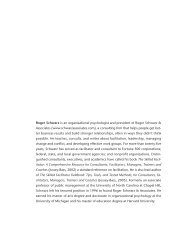The Skilled Facilitator Approach - Roger Schwarz
The Skilled Facilitator Approach - Roger Schwarz
The Skilled Facilitator Approach - Roger Schwarz
Create successful ePaper yourself
Turn your PDF publications into a flip-book with our unique Google optimized e-Paper software.
24<br />
<strong>The</strong> Group Effectiveness Model<br />
To help groups become more effective, you need a model of group effectiveness as<br />
part of your approach. To be useful, the model needs to be more than descriptivethat<br />
is, it needs to do more than explain how groups typically function or develop<br />
because many groups develop in a way that is dysfunctional. To be useful, the<br />
model needs to be normative-that is, it should tell you what an effective group<br />
looks like. <strong>The</strong> group effectiveness model identifies the criteria for effective groups,<br />
identifies the elements that contribute to effectiveness and the relationships among<br />
them, and describes what these elements look like in practice. <strong>The</strong> model enables<br />
you and the group to work together to jointly identify when the group is having<br />
problems, identify the causes that generate the problems, and begin to identify<br />
where to intervene to address the problems. When you are helping to create new<br />
groups, the model helps you and the group jointly identify the elements and relationships<br />
among the elements that need to be in place to ensure an effective group.<br />
A Clearly Defined <strong>Facilitator</strong> Role<br />
To help groups, you need a clear definition of your role as facilitator so that you and<br />
the groups you are helping have a common understanding about and agree on the<br />
kinds of behaviors that are consistent and inconsistent with your facilitator role.<br />
This has become more difficult in recent years as organizations have used the word<br />
facilitator to define many different roles. Human resource experts, organization<br />
development consultants, trainers, coaches, and even managers have sometimes<br />
been referred to as “facilitators.” <strong>The</strong> <strong>Skilled</strong> <strong>Facilitator</strong> approach clearly defines<br />
the facilitator role as a substantively neutral person who is not a group member<br />
and works for the entire group.<br />
<strong>The</strong> <strong>Skilled</strong> <strong>Facilitator</strong> approach distinguishes between two types of facilitation:<br />
basic and developmental. In basic facilitation, the facilitator helps a group solve a<br />
substantive problem by essentially lending the group his or her process skills. When<br />
the facilitation is complete, the group has solved its substantive problem but, by<br />
design, it has not explicitly learned how it improves its process. In developmental<br />
facilitation, the facilitator explicitly helps a group solve a substantive problem and<br />
learn to improve its process at the same time. Here the facilitator also serves as<br />
teacher, so the group can eventually become self-facilitating. Developmental facilitation<br />
requires significantly more time and facilitator skill, and it is more likely to<br />
create fundamental change.<br />
<strong>The</strong> IAF Handbook of Group Facilitation



